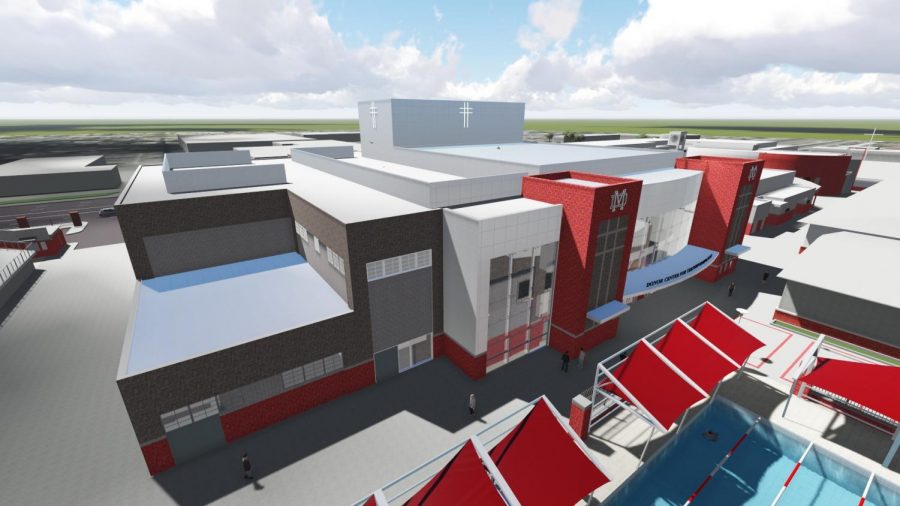Despite the mystery, new Performing Arts Center still in planning
October 27, 2021

While the Little Theatre and Pavillon are the hubs for all things thespian and arts related on campus, there is much mystery surrounding the whereabouts of the new performing arts building – a project that has been in the works for almost two decades. This plan has been in the pipeline for about 17 years, and although most of that time has been spent solely fundraising for the $40 million building, other key decisions about the project have been taking place behind-the-scenes. Despite the enigma surrounding the project, the performing arts department is making strides to get the building started. It may not be much longer until the MD campus begins to prepare for construction again.
On the front lines of the plan, Scott Melvin, executive director of performing arts, acknowledges how things may appear to be stationary from the outside looking in and addresses the progress of the project thus far.
“It’s kind of an interesting situation right now because we have a new president, and we’re also in this era of COVID,” Melvin said. “We have already initiated all the drawings, the schematics, all of the feasibility studies, that type of stuff that goes in before you actually have to have a campaign. We’ve done all that. We’ve been raising money over the last three years.”
Notwithstanding the appearance of where things may be, one thing is certain: the new performing arts building is still a plan in motion.
Melvin points out some of the things students have said regarding other parts of campus undergoing renovations and updates before the theatre and assures the MD community that things happen one at a time and the new performing arts building is still in the works.
“As we continue through COVID, we’ve still been trying to engage our wonderful families and donors and patrons to make sure this happens,” Melvin said. “An interesting stat about this is that the amount of money that has been raised to put up the chapel, the MAC, and everything else that’s happened is pretty much the same amount as what the Performing Arts Center is. We have had incredible support from administration, but we are such a huge athletic school; it’s just plain and simple. We are the number one in the nation, and I can’t deny that. So we had to build the Meruelo Athletic Center (MAC) first – that was something that just had to happen. I understand why people have that perception, and I’m glad I can [talk about the] immense amount of support, immense amount of backing on this, we’ve raised more money on this project than we did on the MAC. Right now is an amazing time as arts come roaring back, and people are excited for the return. We’re hoping that our donors are going to step up and make this a reality for the kids.”
Melvin looked back to the origins of the new structure to explain in more detail why things appear to be moving so slowly.

“We had the first mock-ups done in 2004,” Melvin said. “For a couple of years, we had that. We were raising money for it in 2008. When the [financial crisis of] 2008 happened, and we stopped, it gave us an opportunity to do a reassessment of the programs or reassess the needs. There was a big change that happened there, and then we now have moved into another amendment. It isn’t a huge one, but [we decided] to do it in two different phases – we build the classrooms and have that all going, and then when that is done, we build the theater. So it’s changed majorly twice.”
Bringing the focus back to the present, Melvin realistically doesn’t see the construction starting this school year. However, musical theatre teacher Andrea Fouts optimistically considers the possibility of everything starting up this school year as an actual reality – assuming the money is in place.
“I think that it’s just dependent upon the big donors, and once they agree to a certain amount, I think we could get there and hopefully break ground soon,” Fouts said. “I’m optimistic, and now I’m just really excited, it’s just a matter of finding the right people to donate money.”
Fouts also sees the beginning of construction as something that will negatively impact how theatre classes operate while they find a temporary new place to hold classes. But, even with this, she believes it will be worth it in the long run.
“Most certainly, during construction, we’re going to have to have our theatre classes located somewhere else,” Fouts said. “If that means we’re in a portable building or outside or the parking structure, I think that will be a little disruptive in that manner, but it’s the end goal. We’ve got to keep our heads up […] it’ll serve our school to have such a great performing arts building.”
Along with looking forward to the start of the building’s physical creation, Fouts cannot wait for the opportunities the new theatre will bring to the students.
“My favorite thing is musicals – big, spectacular musicals which we really cannot do here on campus these days,” Fouts said. “So just having a space where we can accommodate a big audience and to do all things technically that I would love to do: be able to fly in big scenery, having moving lights, and basically everything that the students and I can dream – we can put into action on the new stage [and] I think [that is] just the most exciting thing.”
It isn’t just Melvin and Fouts who feel this excitement for the new performing arts portion of campus. Lissa Slay, director of theatre, mirrors their enthusiasm. The addition of a new building for theatre also means the addition of a new home for learning about the physical, hands-on portions of the theatre arts.
“[The new Performing Arts Center] means a bigger home for my students,” Slay said. “It will absolutely be transformative to my teaching, there’s no doubt about it. Sometimes parts of it, like light rail queues – we don’t have rails here, we don’t have a pulley system, so I can’t show them what real queues actually look like… I don’t have drapes that can draw. I don’t have moving lights, or a hazer, or a fogger, or any of these things that I might have that come pretty standard to any other working space. I would love to be able to start there and not just talk about the theory, but actual practical application – let’s talk about it, let’s do it. We’re going to see all the elements of theatre come together at the same time.”
Regardless of her elation towards the new home for theatre, Slay aligns with Melvin in thinking that starting this project mid-school year may not be realistic.
“We’re in the middle of the school year, and so I don’t think that we would start a big project [like this] – that would be a huge disruption to life on campus,” Slay said. “So I think if anything, it’s definitely logistically possible to see it happen in the summer. But I don’t see it happening as people are navigating around Heisman Lane and the pools – at the same time, nothing’s impossible.”
Above all, the new Performing Arts Center goes beyond the numbers and practical application of having brand-new facilities to teach in. Slay concludes that even without a state-of-the-art building to work in, students can make art – specifically theatre – happen anywhere.
“Wherever the theater program and students, the artists, these theater-makers are – whatever space they’re in – I know that they will continue to create, tell great stories and do good work. They have proven that they continue to do the work, and I could ask nothing more than that.”








